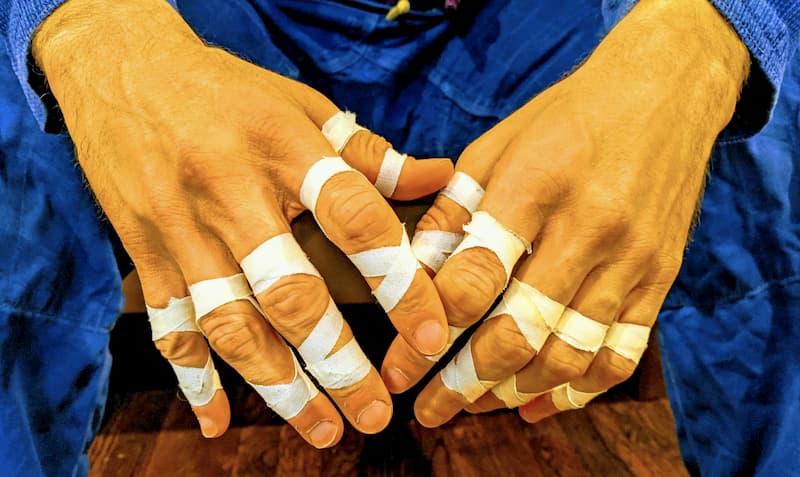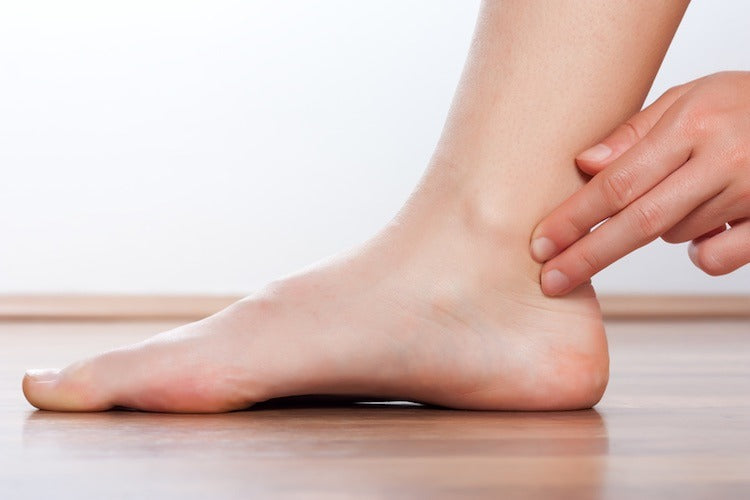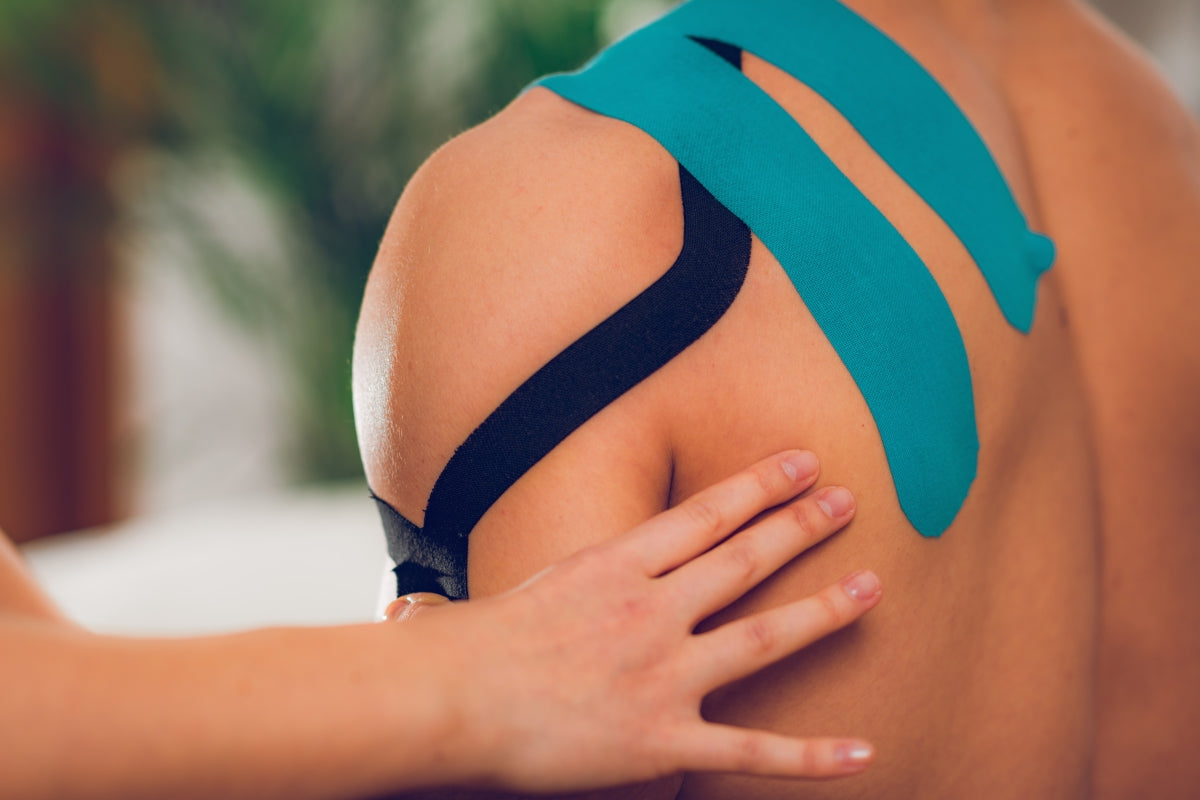
Brazilian Jiu-Jitsu (BJJ) is an intriguing sport. A martial art of Japanese origin known for its effective self-defense-themed techniques aimed at dominating opponents with grapples and submissions. Beyond the athletes' physical acrobatics, one extra highlight of the sport catches the eye—their wrapped fingers. Athletes—veterans and trainees—often wind white, black, or colored tapes around their fingers in competitive and training settings. You must have noticed at some point.
These BJJ finger tapes are not just fashion statements, nor are they for aesthetics, but they serve profound purposes in the sport. In this article, we discuss these functions, how to wear these tapes properly, and the types of tapes. If you are a newbie seeking to embark on the Brazilian Jiu-Jitsu journey, or an enthusiast of the arts, dig in for an engaging read.
Why BJJ Tapes?
They Help Protect Your Fingers and Fortify Your GripBrazilian Jiu-Jitsu is undoubtedly a sport that is as intense as they come. From the outset, the constant grapples, ground fights, submissions at training sessions, and even competitions take an immense toll on unprotected fingers. Over time, swellings and injuries to your joints and phalanges (finger bones) may ensue.
In the most drastic of cases, it could eventually set off arthritis in your fingers. All these wear down your hands and dampen progress in your Brazilian Jiu-Jitsu career in the long run. However, BJJ finger tapes nip these potential problems right in the bud.
When you wear them appropriately and consistently, they protect your fingers and spare them from continual insults and trauma of the sport. They also help you fortify your grip, particularly when injury-free.
They Provide Support and Help You Build Your Finger Strength and Your Confidence—Especially if You Are a Newbie
Like many sports, Brazilian Jiu-Jitsu requires time to get used to its rigor. With time and grit, your fingers and other parts of your body get used to the sport. If you are a newbie, the swelling of the joints and the strain of the tendons of your unconditioned fingers are inevitable as you train.
This often leaves them further prone to damage. However, you may end up sustaining many injuries along the way. Some may be debilitating. In other cases, the fear of further injury may even cause you to hold back during training. Ultimately, it might impede your progress.
Using BJJ tapes alleviates these problems. When you tape your unconditioned fingers, you support them. This allows you to go all-out as your fingers get conditioned to the sport. In other words, they help you build your finger strength with minimal sustained damage as you go on. They also allow you to muster the confidence to perform finger-straining techniques with little bother.
They Keep You Training and Competing Longer
Due to the support and protection they offer, BJJ tapes keep athletes—whether professional or upcoming—longer in the game than if they didn't use them. Over the years, accumulated injuries have caused renowned veteran athletes to lose their spark. It consequently draws them away from the spotlight.
Many aren't able to perform the diversity of techniques they used to. Moreover, their regular skills lose effectiveness too. This is due to the pain and the slow weakening of their fingers. Using BJJ tapes grants them a bit of longevity in their career. It keeps them in the thick of it all longer than if they didn't use them.
They Help Cover Injuries
BJJ tapes do not just help you steer clear of injuries. They help you manage them as well. Some athletes wear BJJ tapes to cover bruised, sore, or scarred knuckles and fingers. This helps prevent them from getting worse, pending proper treatment—if it is required. However, in this regard, these tapes are not usually worn directly over the injury. They are worn over bandages.
How to Wear BJJ Tapes
There are many ways to strap on these tapes for their apparent benefits. Four of them are highlighted below:
X-Taping
X-taping provides support without compromising the mobility of your joints. Moreover, it offers protection for injured fingers or sore joints as well. The only probable downside to this taping method is that it might require a lot of tape. Hence, you should buy long tapes intentionally if you intend to use this method consistently.
Here is how to pull it off:
- Pick a spot on the inside of your finger, just above the joint farthest from your wrist (do not wrap tape directly around a joint as it would impair mobility). Wind the tape around it a few times.
- Then wrap the tape diagonally over the palmar part of your finger, crossing to the other side. Stop after you have crossed the second joint. Wind it around your finger a few times once more.
- Wrap diagonally, crossing to the other side. Go as far down as knuckles, and wrap around it again. When you are through, cross diagonally to the other side to form an X-shape on the palmar side of your finger.
- Repeat the step above and move upwards until you reach where you started. Cut off the tape when you are through.
Buddy Taping
Buddy taping refers to the wrapping of two fingers together with single taping. Athletes use this taping method to support injured fingers or joints, especially during competitive settings. This method prevents you from overly extending or flexing the injured joints, thus minimizing pain and keeping you active.
- Start from the insides of the two fingers above the point of the injury. Alternatively, you could start above the joints farthest from the wrist.
- Depending on your choice, you could perform a single-taping or an X-taping method to hold the two fingers together.
Thumb Taping
The thumb is slightly different from the other fingers due to its positioning and function. Winding tape around your thumb may cause your grip strength to reduce. It, therefore, follows that protecting it with BJJ finger tapes will be slightly different as well. Nonetheless, if you are particular about protecting your thumb against all odds, the pros of taping outweigh the downside.
Here is how to thumb tape:
Start from the inside of your thumb, above the farthest joint from your wrist.
Proceed to wrap around your thumb using a single or X-taping method.
You can wind the tape down to your wrist, depending on your choice.
Restrictive Taping
Restrictive taping is straightforward compared to the other forms of taping. Like buddy taping, athletes resort to restrictive taping as a quick remedy if they sustain an injury in a competitive setting.
All you need to do is: Apply the tape directly and wind it around the injured part of your finger. This is not a lasting remedy. After you are done, you should take care of your finger. If you have to use these tapes again, you will wear them on your bandage.
Types of BJJ Finger Tapes
BJJ finger tapes can be grouped into types based on:
Width.
Length.
The material.
Width
The most common BJJ tapes on the market are either
⅜ wide
⅜ inches wide, or
½ inches wide.
It is noteworthy that widths up to 1½ inches are not uncommon on the market. Tapes with smaller widths are more suited to the width of fingers. They hardly need trimming or further adjustments during use. The larger ones usually do.
Length
The lengths of BJJ tapes range from about 30 feet long to lengths reaching 45 feet.
Material
BJJ tapes are usually made from sturdy material due to the functions they perform. These materials can be tough cotton, rayon, or rubber.
These tapes may come in white, black, or, less commonly, other colors. Also, it is noteworthy that these tapes are different from regular athletic tapes. They are smaller than the latter and are more equipped for sweaty sessions.
Why Hampton Adams?
Hampton Adams 8 Pack 0.3 inch BJJ Finger Tapes is a leading brand that offers all the apparent benefits you could seek in finger tapes. Our tapes come at a generous price that is clear of other competitors in the market. Each package is at least two more than the average competing brand pack in the market.
Our tapes are made from cotton of tough, non-flexible quality and texture. Thus, they are durable and can hold their own against moderate sweat and other forms of moisture. Furthermore, the super-strong adhesives on them do not leave residue on your skin after use. They are also skin-friendly and do not cause irritation or set off allergies during use. It makes them ideal for all demographics—the hypersensitive included.
What is more? These tapes are as versatile as they come. They can be just as effective for rock climbing, grappling, and other forms of martial arts. It is due to the durability of these tapes. In other words, the ability of these tapes to keep up with the rigor of these sports.
Furthermore, their off-the-charts compression strength, which goes hand-in-hand with optimum comfort, further cements them as a foremost choice for pros and newbies in sports. To assure you of our integrity and bolster your trust in our brand, we offer purchase protection. If you have reservations about our tapes, we will double-refund your money—although we are sure it would hardly come to that.
Interested in purchasing one of these BJJ finger tapes? Visit Hampton Adams' website today to book an order.



